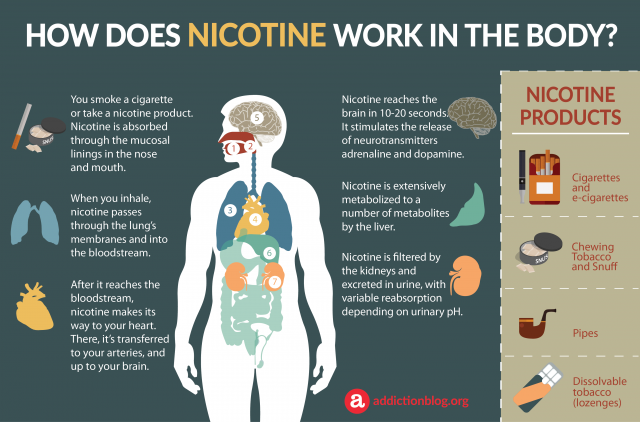Nicotine is One of the Most Addictive Substances Known to Man
Nicotine is one of the most popular drugs in the world. But it is also one of the most addictive! Nicotine is most commonly administered in the body by smoking tobacco. However, some people can get a nicotine rush by:
- chewing tobacco
- snuffing tobacco
- inhaling nicotine vapor
In addition to its purely recreational attraction as a mild stimulant, nicotine can trigger focusing effects. In fact, many people find nicotine useful for improving productivity, combating anxiety, and aiding mental focus. The way in which the “smoking is deadly” message has been presented leads us to believe that chemicals added to cigarettes by manufacturers cause most health risks. But pharmaceutical nicotine products and electronic cigarettes are as equally harmful as smoked nicotine.

What can nicotine do in the long-term?
These are some of the health risks associated with the long term exposure to nicotine:
- acute hypertension
- dizziness
- heart attack
- heart rate increase
- lung cancer
- oral cancer
- osteoporosis
- risk of diabetes
- sleep disturbance
- stroke
- tremors
In sum, nicotine is harmful and dangerous. Nicotine particularly targets the brain. Over time, regular nicotine use affects the GABA neurons in the brain; they become desensitized and lose their inhibitory effect on dopamine.
In this infographic, we present how nicotine affects each organ of your body. We gladly welcome all your questions about symptoms of addiction to nicotine in the section at the end. We’ll make sure all your questions are answered personally and promptly.
How Does Nicotine Work In The Body?
1. You smoke a cigarette or take a nicotine product.
2. NOSE & MOUTH: Nicotine is absorbed through the mucosal linings in the nose and mouth.
3. LUNGS: When you inhale, nicotine passes through the lung’s membranes and into the bloodstream.
4. HEART: After it reaches the bloodstream, nicotine makes its way to your heart. There, it’s transferred to your arteries, and up to your brain.
5. BRAIN: Nicotine reaches the brain in 10-20 seconds. It stimulates the release of neurotransmitters adrenaline and dopamine. This is why nicotine is highly addictive.
6. LIVER: Nicotine is extensively metabolized to a number of metabolites by the liver.
7. KIDNEYS: Nicotine is filtered by the kidneys and excreted in urine, with variable reabsorption depending on urinary pH.
NICOTINE PRODUCTS
- Cigarettes and e-cigarettes
- Chewing Tobacco and Snus
- Pipes
- Dissolvable tobacco (lozenges)
Nicotine in the Body Questions
In this infographic, we tried to cover the basic metabolism in the body and mind of nicotine users. If you have additional questions, please do not hesitate to post them in the comments section below. We try to answer all legitimate inquiries personally and promptly.
Get Personalized Addiction Treatment Text Support
Receive 24/7 text support right away and at your convenience. There is no obligation to enter treatment and you can opt out at any time.
Want to get help, but not ready to talk? Instead, sign up for text support to receive:
- Resources about addiction and recovery
- Information about our treatment process








Related Posts